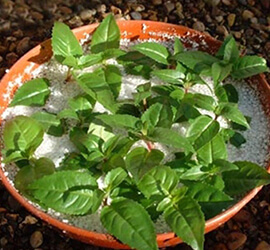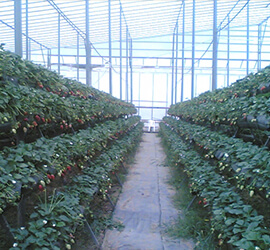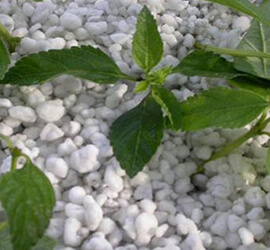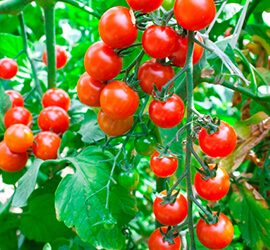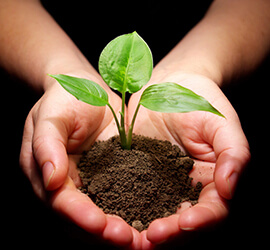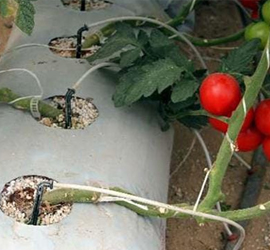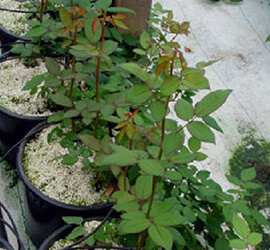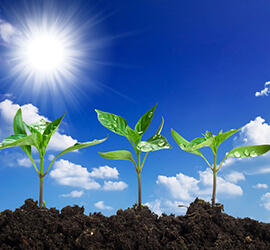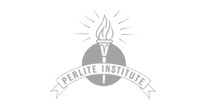Agricultural Perlite
- Home
- Agricultural Perlite
USAGE OF PERLITE IN AGRICULTURE
- Perlite makes soil ventilated and improves its drainage with its %90 porosity
and %60 ventilation porosity.
- Perlite increases infiltration, decreases evaporation. Provides economical watering
procedure.
- Doesn’t carry weed seed or illness because its an inorganic material.
- Perlite doesn’t cause saltness and alkalization problems because of less amounts of
soluble ions in it.
- Regulates pH values with its chemical buffering properties and notralized pH (pH= 6,5-7,5).
- Because of its lower electrical conductivity, it protects plant from daily temperature changes.
- In non-soiled agriculture activities; it brings advantages of usage with sterilization and usage for
6 years. It can provide early production.
- Prevents injuries and losses at seedling roots.
USAGE IN MALTING AND SEEDLING GROWING
Perlite is available environment for vegetable and flower germination. Moistened perlite is filled in these flower pots. After that it is watered. Sowing must be made in deeper surfaces. In sowing areas seedles are kept until they will become parallel when their cotyledon leaves opened. In this period there is no need for extra food because plant uses nutrient in itself. When seedles are in this appearance they must be lapped. Because there is cornicing in taproot after this period. Delay in lapping can cause taproot losses. Seedles are usually carried with plastic bags. Plastic bags can be filled with 1:1 ratio of Perlit-torf soil mixture. But also it can be filled with only Perlite. To 1 m3 of Perlite-torf mixture there will be addition of 600 gr. P2O5, 400 gr. K2O, 300 gr. N, 100 gr. Mg. There is watering with melted food with poor perlite bags.This application is suggested for greenhouse applications. Perlite’s advantage as germination environment is lagging procedure without damages. It can be used for years because it is sterilized and maintain its characteristics. Perlite must be super grain sized in order to use for germination.
USAGE IN ROOTING ENVIRONMENT
Perlite can be used in rooting for flower,vegetables or fruits alone or by mixing them. If folding is done only filling perlite; first perlite must be moisturized and offshoots must be put in to the moisturized perlite. This is enough for keeping perlite moisturized.As rooting environment perlite can be mixed with another inorganic material from 1:1 up to 1:9 ratio.If soil is desired there must be soil mixture with 5 scale of perlite and 1 scale of inorganic material.Watering of folding environment regularly and keeping environment hot and moisturized is important.Perlit that will be used in rooting environment must be coarse grained for obtaining healthy roots.Perlite can provide excellent rooting environment. But there can be higher profits obtained by not buying expensive vegetable seeds. Tomato and cucumber roots can be used for production.
PERLITE AS GROWING ENVIRONMENT
Perlite has important advantages both in soiled or non-soiled environment.
PERLITE IN SOILED CULTURE
Perlite is used for soil regulator or as agent for decreasing water losses. There are expectations from good soil regulator as higher water capacity,base difference and higher heat capacities with lower salt amounts and heat conductivity.When perlite is mixed into heavy and sticky soils, it prevents swelling and shrinkage, fissuring, ponding with its drainage and ventilation properties.Perlite can increase water holdingcapacity of soil and effectivity of food materials.
Perlite can change physical properties of greenhousing soils instead of chemical properties of greenhouse soil. In greenhouse with sub-irrigation and drip irrigation applications, by pouring 4-5 cm of coarse grain sized perlite water usage can be decreased in half. There is an experiment followed in Ege University Faculty of Agriculture. Perlite is mixed with 1:4 ratio of coarse grain sized greenhousing soil. Tomatoes in this greenhouse is watered 6 times but other greenhouse soil is watered for 21 times in same time period. This proves that Perlite has positive effect on water losses and labor work.
PERLITE IN NON-SOIL ENVIRONMENT
There is non-soil environments created for preventing problems caused by tired greenhouse soils. There is non-soil environment applications up to %95 percentages in many countries around world. Perlite can be used alone in these applications. But also peat, sand, tree and bark mixture can also used.In non-soiled environment perlite and perlite mixture is poured on greenhouse soil with black plastic covering in 10-15 cm thickness.Melted food is used for plants to satisfy their needs for water and food.Other application plants are growth in 5-10 litres of packages filled with perlite or another perlite mixture. This procedure is also easy as others. Because this production consists of pouring these mixtures on black plastic coverings and feeding them with melted foods and satisfying their needs of water and food.
Advantages of non-soiled culture
- Water and food dosages can be settled easily.
- Crop rotation in soiled agriculture becomes less important.
- Problems caused by illness and harmful elements in soil or weeds can be decreased.
- Economic water usage can be reached by the help of decreasing the losses in leakage and evaporation.
- There is no need for higher potential of labor work and tillage, cleaning, disinfecting and fertilization
because of soil inactivation.
- Agricultural areas can be increased because there is no need for soil for agricultural activities.
USAGE IN PERLITE IN TURF FIELDS AND SOIL FIELDS.
Perlite is unique regulator for parks,gardens and also for football and golf fields. Grass can be weakened or dissapeared because of the outer effects.
- Perlite can increase the life of grass,prevent ponding and sliming problems.
- There is increase in leaves and roots between perlite and grass. Squeezing is
reduced to half.
- Perlite application is same for squeezed or non squeezed grass. 2,5 cm thickness of perlite
is mixed with same amount of soil and 5 cm of mixture is reached. Perlite must be watered
before application. There must 4-5 kg/m2 of burned droppings and if possible 100 gr/m2
limestone must be poured on it. If there will be usage of industrial droppings instead of natural
droppings; %26 percentage of nitrate, %18 percentage of 65 gr/m2 phosphate and 15 gr/m2
of potassium sulfate mixture must be used regularly.There will be no changes in watering.
- In grass fields standard or coarse grain sized perlite must be used.
- Perlite must be mixed into soil homogeneously and before first cutting there must be rolling. Cutting
must be made with scissors.
- In soil fields this application is used for flexible soil and obtaining soft floor.Perlite is used under
top surface.Perlite is used in %30 percentage of the field.




